Flooding can be dangerous, not just when the water rises, but also in the aftermath as hazards remain. This page will guide you through the key steps to staying safe during a flood and what to do once the water subsides. From avoiding hidden dangers in floodwater to protecting your health and home during recovery, it’s important to be prepared.
Remember, if there is an immediate risk to life, always call 999.
Flooding can create serious safety risks, both during the event and in the aftermath. Fast-moving water, hidden hazards, and contamination can be dangerous, while damage to buildings and infrastructure may pose ongoing risks during recovery.
This page will guide you through key aspects of flood safety, helping you understand what to do before, during, and after a flood.
During a flood, always follow the advice of professionals and emergency services. If there is an immediate risk to life, call 999 for help. Never enter or drive through floodwater – it can be deeper and more dangerous than it looks.
Hover your cursor over the image below to discover the hidden dangers of flooding.
Reporting flooding is critical in ensuring that risk management authorities (RMAs) are aware of problems and can respond effectively. By reporting each incident, you help authorities collate data and track the overall picture of flooding in your area.
Flooding can come from different sources, so it’s important to know who to report it to.
If you experience flooding, it is essential to report it as early as possible to the relevant authority. We do not process flood reports on this website. Please use the link below to find the correct authority to contact.
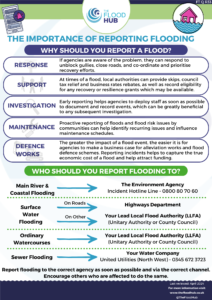
Click here to download ‘The Importance of Reporting Flooding’ resource.
In the event of a flood, it is crucial to listen to emergency services and follow their instructions. They have the expertise to assess the situation and determine the safest course of action. If you are advised to evacuate, it is for your safety as floodwaters can rise quickly, cutting off escape routes and putting lives at risk. Leaving your home may be difficult, but emergency responders will only recommend evacuation if staying put is more dangerous.
Even if evacuation isn’t necessary, emergency services may advise you to take other precautions, such as moving to higher ground, avoiding flooded roads, or turning off gas, electricity, and water supplies to prevent further hazards. Always follow official updates from sources like the Environment Agency, emergency services, and local authorities. Be prepared to act quickly and prioritise safety above all else.

Entering floodwater may seem safe, but it conceals significant risks, with one of the most severe threats being drowning. Floodwaters can rise rapidly, making it easy for people to become trapped or disoriented. Walking or driving in floodwater is especially dangerous due to its unpredictable strength. The water can suddenly sweep you or your vehicle away, leaving you stranded and in danger of drowning. Just 15 centimetres (about 6 inches) of moving water can push a person off their feet.
Avoiding fast-flowing rivers or standing too close to the sea during storm surges. The strong currents in rivers can swiftly sweep individuals away, while storm surges along the coast can lead to substantial waves, flooding, and powerful winds, all of which are extremely dangerous and pose a significant risk to life.
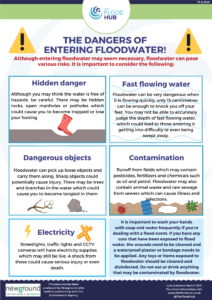
Click here to download the ‘dangers of entering flood water’ resource.
During floods, the murky and turbulent water often obscures its actual depth, causing people to underestimate the associated risks. Floodwaters can conceal hazards such as potholes and manholes, which are challenging to spot while submerged and can lead to falls or becoming trapped. Additionally, floodwaters can transport debris capable of causing injury, highlighting the need for caution and vigilance when dealing with floodwater to prevent potential harm or accidents.
Floodwater can be dangerously cold, and the shock of cold water can severely impact your ability to breathe and swim, even for the most experienced swimmers. The RNLI advises that if you end up in difficulty in the water, follow these steps:
Float first: Fight the instinct to swim immediately and allow yourself to float to regain control.
Control your breathing: Focus on regulating your breathing to prevent panic.
Kick to the side: After calming your breathing, gently kick to the side to move to safety.
These steps can be lifesaving in the event of encountering floodwater. If you’re in immediate danger, call 999 for help.
For more advice, visit the RNLI’s Float to Live page: https://rnli.org/safety/float
In addition to physical hazards, floodwater may contain harmful substances, including pesticides, chemicals, sewage, animal waste and oils, posing health risks on contact. Cuts or wounds exposed to floodwater should be promptly cleaned and protected with waterproof plasters.
Frequent handwashing is essential to prevent the spread of contaminants, and items exposed to floodwater should be thoroughly cleaned and disinfected, if possible.

During floods, streetlights, traffic lights, and CCTV cameras may still have live electricity supplies. Water is a powerful conductor of electricity, meaning that floodwater in contact with live electrical sources can carry a dangerous current. Contact with electrified floodwater can result in severe shocks, serious injuries, or even death. Avoid wading or driving through floodwater whenever possible, especially near power lines, electrical cabinets, or submerged infrastructure. If you suspect floodwater may be electrified, stay away and report the hazard to the relevant authorities immediately. Extreme caution is essential to stay safe.
Driving through floodwater is extremely risky. The water can suddenly sweep your vehicle away, leaving you stranded and in danger of drowning. In standing water, research shows that as little as 30cm (11 inches) of water can cause vehicles to lose contact with the ground, leading to a loss of control. In flowing water, a depth of 60cm (23 inches) can carry a vehicle away.
Even if the water appears shallow, it can conceal deep holes or road damage which can harm you and your vehicle. Floodwater can erode the road, forming hidden gaps and weak sections. Venturing into these areas can result in accidents and vehicle damage. It only requires an egg cup’s worth of water in your engine’s intake to stall your engine and potentially cause thousands of pounds worth of damage.
Additionally, it’s important to note that bow waves created by vehicles moving through floodwater can not only damage property but also pose a danger to people.
For your safety and that of others, it is crucial to avoid driving through floodwater. Instead, turn around and seek an alternative route to ensure safety.
For more information on safe driving in floodwater, you can explore our dedicated blog by clicking here.
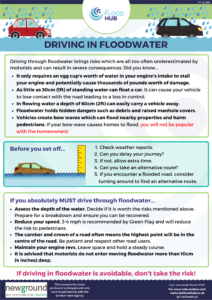
Click here to download the ‘Driving in Floodwater’ resource.
As the waters subside after a flood, safety remains a top priority during the recovery phase. This section guides you through crucial safety measures, addressing potential hazards post-flood. For more in-depth information and practical tips on flood recovery, click here to visit out household page.
Before re-entering your home after a flood event, take a moment to assess its structural condition. Floodwater can erode foundations, damage load-bearing walls, and harm essential systems like electrical and plumbing, compromising the overall structural stability. Look for warning signs such as cracks in walls, doors that no longer close properly, warped floors, or a sagging roof, as these could indicate serious structural issues. Additionally, be mindful of potential gas leaks or exposed wiring, as these can pose fire and health hazards. If you notice any visible damage, do not attempt to enter and consult with a professional, such as a structural engineer or building inspector, before proceeding to avoid potential risks.
Click here to read more about flood recovery on our household page.
Stagnant water can quickly become a breeding ground for diseases, especially when left standing for an extended period. It can contain harmful bacteria, sewage, and chemicals, increasing the risk of illness and infection. To prevent this, promptly remove any stagnant water from your home using pumps, buckets, or wet vacuums and ensure proper drainage. When cleaning up, wear rubber gloves and appropriate personal protective equipment to reduce the risk of exposure to harmful contaminants.
Stagnant water not only poses health risks but can also weaken your home’s foundation, rot wooden structures, and encourage mould growth if not managed effectively. Once standing water is removed, clean all surfaces thoroughly with disinfectants to eliminate bacteria and contaminants. Porous materials like carpets, mattresses, and upholstered furniture that have been soaked should be discarded, as they are difficult to fully disinfect and can harbour mould and bacteria.

Drying out your property is an essential step in the recovery process after a flood. However, it’s crucial to do this safely to avoid further damage or health risks. Open windows and doors to increase airflow and speed up the drying process, and use dehumidifiers, heaters, and fans to remove excess moisture from the air. Mould and mildew can start growing within 24 to 48 hours, so it’s important to act quickly. These fungi thrive in damp conditions and can cause serious health problems, particularly for those with respiratory conditions, allergies, or weakened immune systems. Exposure to mould spores can lead to breathing difficulties, skin irritation, and allergic reactions, while prolonged exposure may worsen conditions like asthma. Mould can also cause unpleasant odours and weaken the structural integrity of your home by breaking down materials like plaster and wood.
If using electric appliances, ensure they have been checked by a professional before plugging them in. Never use petrol or diesel-powered generators indoors, as they release Carbon Monoxide (CO), a colourless, odourless gas that can be deadly if inhaled. Always place generators outside, away from windows and doors, to ensure proper ventilation. If you’re unsure about any structural or electrical damage, seek professional advice before attempting to dry out or repair your home.
It’s crucial to avoid consuming any food or drink that may have been contaminated by floodwater, as they can carry dangerous bacteria and pathogens that can cause severe illnesses if ingested. Floodwater can also contaminate mains water supplies, wells, and storage tanks, so it’s important to check your drinking water source too. Throw away any food that has come into contact with floodwater, even if it looks safe to eat, as packaging may not be watertight and harmful bacteria can still be present. When in doubt, it’s always safer to dispose of potentially contaminated items rather than risk illness. Any food that has been in contact with floodwater or has perished due to flooding should be promptly discarded, as consuming it can pose severe health risks with potentially fatal outcomes.
After encountering floodwater, wash your hands thoroughly with soap and clean water—this seemingly simple step is a powerful defence against waterborne illnesses. Additionally, consult your local council for up-to-date information on how to dispose of other contaminated items such as sandbags, furniture, and household goods to ensure proper and safe disposal.
Flooding can have profound and enduring impacts on mental health, often affecting individuals and communities long after the floodwaters recede. The aftermath of a flood, with its challenges such as displacement, financial stress, and complex insurance claims, can lead to increased risks of mental health issues like depression, anxiety, and post-traumatic stress disorder. Vulnerable groups like the elderly and children may be particularly affected. Click here to read our blog on mental health and flooding.
Children can suffer badly because of flooding but they can also be great sources of support to their families, neighbourhoods and communities in an emergency. Initiatives like school education programs aim to support affected children. Click here to visit our ‘How does flooding affect children?’ page, and click here to read Lancaster university and Save the Children’s ‘Children, Young People and Flooding: Recovery and Resilience’ report.
Those who have been affected by flooding and require further support should contact their GP or NHS 111 in the first instance. There are also organisations such as MIND who can provide advice and guidance on accessing support services as well as a range of mental health related information. You can contact MIND directly on 0300 123 3393 or by visiting www.mind.org.uk.
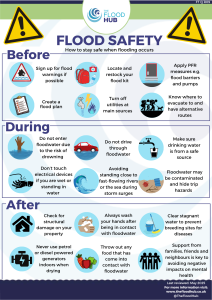
Click here to download the flooding safety resource.
To download resources associated with flood safety, visit the Flood Safety Toolkit by clicking here. This collection includes essential resources and blogs covering key safety aspects to consider before, during, and after a flood. Click on each resource in the toolkit to download it and build your own toolkit!
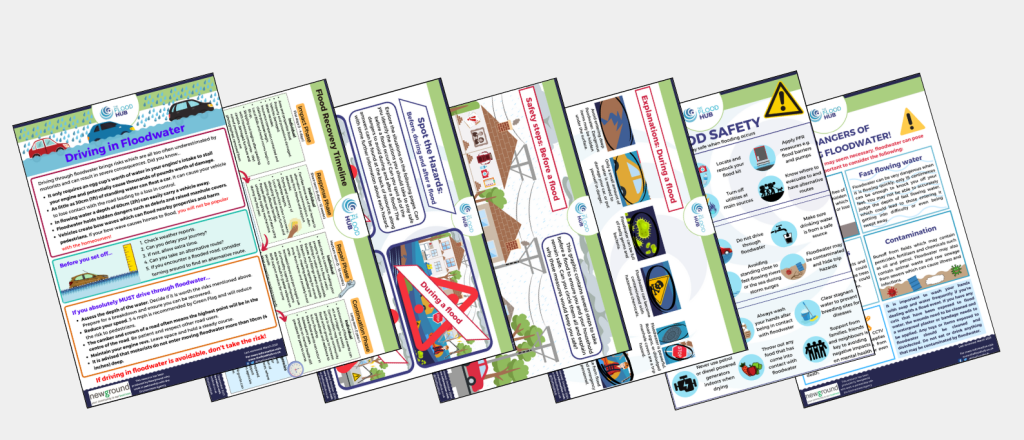
For even more materials on resilience, explore our Knowledge Hub by clicking here.
It’s important for children to understand flood safety so they know what to do if flooding occurs. Teaching them the risks and how to stay safe can help reduce fear and ensure they respond calmly in an emergency.
We have a range of learning resources across our website to help children learn about flooding and how to stay safe. Our KS2 flood education package covers key topics, including:
Alongside these lessons, we offer engaging activities such as our Spot the Hazards: Before, During, and After a Flood resource, which helps children recognise dangers and learn how to act safely in different flood situations. Click here to download.
Encouraging children to get involved in flood safety education will help them feel more prepared and confident, ensuring they know what to do to protect themselves and others in the event of a flood.